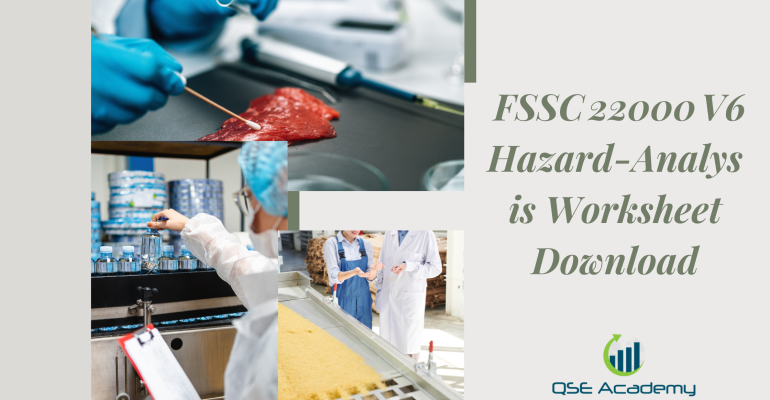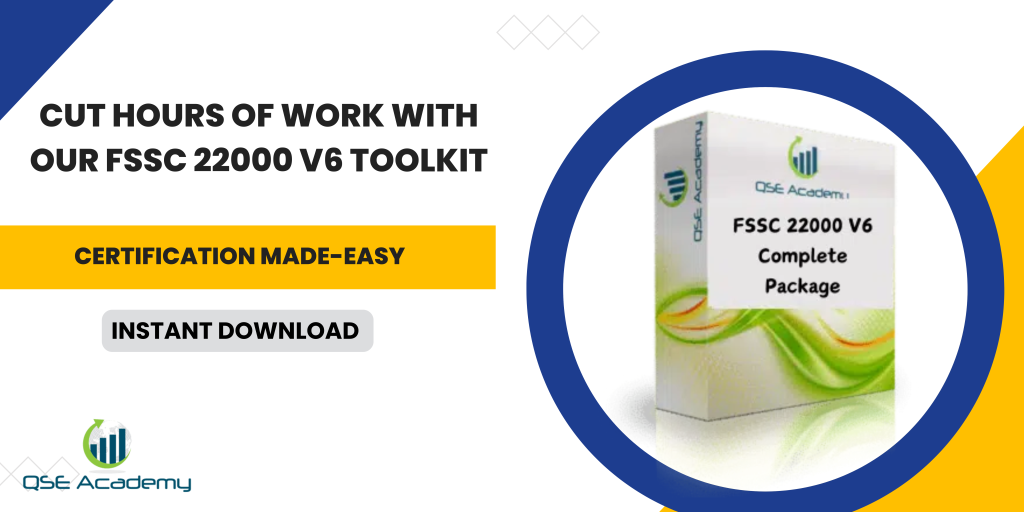FSSC 22000 V6 Hazard‑Analysis Worksheet Download
Why a Structured Hazard-Analysis Worksheet Changes Everything
Every food business knows hazard analysis is important — but few have a clear, simple system for it.
I’ve seen teams spend hours in HACCP meetings debating risks, only to end up with a spreadsheet that confuses everyone. That’s where structure changes everything.
A hazard-analysis worksheet is your decision-making backbone. It connects what could go wrong with how you’ll prevent it, and it must align with FSSC 22000 V6 requirements.
In this guide, I’ll walk you through exactly what to include, how to fill it out, and share a ready-to-use Excel worksheet you can download — one that passes auditor expectations with zero confusion.
Purpose of the Hazard-Analysis Worksheet in FSSC 22000 V6
Your hazard-analysis worksheet isn’t just paperwork — it’s the heart of your Food-Safety Management System (FSMS) under Clause 8.
It helps you:
- Identify and evaluate hazards at every process step
- Determine which controls are needed
- Document why a hazard is or isn’t significant
- Show auditors clear logic behind your HACCP plan
Think of it as your FSMS blueprint. Each line in the worksheet connects product safety to real-world control.
Pro Tip: Always analyze biological, chemical, physical, and allergenic hazards together. When you separate them, you lose context — and auditors pick up on that.
Common mistake: Treating the hazard list as permanent. Processes change, ingredients evolve, suppliers come and go — your worksheet must evolve with them.
 Key Columns and Data Fields Every Worksheet Should Include
Key Columns and Data Fields Every Worksheet Should Include
The best worksheets are simple, logical, and complete. Here’s a layout that works beautifully under FSSC 22000 V6:
| Column | Description | Example |
|---|---|---|
| Process Step | Where the hazard occurs | Metal detection |
| Potential Hazards | Biological / Chemical / Physical / Allergenic | Metal fragments |
| Preventive Measures / PRPs | Controls already in place | Magnet & sieving |
| Severity (S) | Impact if hazard occurs | 4 = Major |
| Likelihood (L) | Probability of occurrence | 2 = Occasional |
| Risk Rating (S × L) | Risk score | 8 |
| Control Measure Type | PRP / OPRP / CCP | CCP |
| Monitoring Method | How you verify control effectiveness | Hourly detector test |
| Corrective Action | What happens if control fails | Stop line & isolate lot |
Pro Tip: Use color-coded cells — green for PRPs, yellow for OPRPs, red for CCPs. It gives the HACCP team a quick snapshot of your control landscape.
Example: A ready-meal producer switched to this color-coded format and cut review time in half. No more debating what was “significant” — the risk scoring did the talking.
Step-by-Step: How to Fill Out the Worksheet for FSSC 22000 V6
Step 1 – List All Process Steps
Start with your process-flow diagram. Then walk the line — literally. I always advise teams to verify flowcharts on the factory floor; you’d be surprised how often new equipment gets added without updating documents.
Step 2 – Identify Potential Hazards
Brainstorm every possible hazard. Involve operators, maintenance, and QA. They know where issues really happen. Cover biological, chemical, physical, and allergenic hazards for every step.
Step 3 – Assess Severity and Likelihood
Score each hazard using a 1–5 scale for severity and likelihood. Multiply them for a risk rating. Define thresholds — for example, any score ≥ 9 counts as significant.
Step 4 – Define Control Measures
Decide how each hazard will be managed — through a PRP, OPRP, or CCP. Link controls to their monitoring procedures.
Step 5 – Validate and Review
Finally, confirm that every significant hazard is controlled. Keep meeting minutes or approval signatures — auditors want proof your team reviewed and agreed.
Pro Tip: Add a “Rationale” column for why each hazard was or wasn’t significant. It’s the easiest way to silence audit questions later.
Common mistake: Marking everything as “significant.” Not every hazard deserves a CCP — that defeats the purpose of risk prioritization.
Aligning Your Worksheet with FSSC 22000 V6 Requirements
FSSC 22000 V6 doesn’t change the hazard-analysis process, but it strengthens what must be documented.
Here’s what alignment looks like:
- ISO 22000:2018 Clause 8.5 → Hazard control planning
- PRPs → Reference ISO/TS 22002 series
- FSSC Additional Requirements → Include hazards tied to Food Fraud, Food Defense, and Allergens
Pro Tip: Add a “Reference” column linking each control to an SOP or record (like CCP-PROC-03). Auditors love traceability.
Example: A beverage plant built this reference system into their Excel sheet. During audit, the lead auditor said, “This is one of the clearest hazard analyses I’ve seen.” That’s what traceability does — it builds confidence.
Maintaining and Reviewing the Hazard-Analysis Worksheet
A hazard analysis isn’t a one-and-done exercise — it’s a living record.
Review it at least once a year, or sooner if:
- You add a new product or ingredient
- You change equipment or layout
- There’s a supplier change
- An incident or recall occurs
Tie reviews to your management-review meetings. It keeps your system proactive instead of reactive.
Pro Tip: Keep past versions archived. Auditors sometimes ask, “How did your analysis change after last year’s updates?” Having dated versions shows maturity.
Common pitfall: Losing track of revisions when multiple people edit the sheet. Assign one owner — usually the HACCP Team Leader — to manage updates and approval.
Benefits of Using a Ready-Made Worksheet Template
I’ve built and audited hundreds of hazard analyses, and one thing’s clear: structure saves hours.
Here’s what a professional template does for you:
- Ensures every required field is covered
- Reduces inconsistent scoring across departments
- Speeds up HACCP meetings and audits
- Makes risk prioritization visual and evidence-based
Example: A frozen-dessert plant adopted QSE Academy’s worksheet template and cut HACCP review meetings from two days to one. Their auditor finished hazard analysis verification in just 45 minutes.
When you start from a solid structure, your team spends time thinking — not formatting.
FAQs — FSSC 22000 V6 Hazard-Analysis Worksheet Explained
Q1. Is there a specific worksheet format required by FSSC 22000 V6?
No, the standard doesn’t prescribe a format. But your worksheet must clearly show hazard identification, assessment, and control decisions.
Q2. Do I need separate worksheets for each product line?
Yes, if the processes differ. Shared PRPs can be referenced, but distinct steps need their own analysis.
Q3. Can I keep my worksheet digital?
Absolutely. Electronic versions are fine as long as they’re controlled and accessible during audits.
Conclusion — Download Your Ready-to-Use Hazard-Analysis Worksheet
A solid hazard-analysis worksheet turns your HACCP process from guesswork into strategy. It’s not just for auditors — it’s for your team’s clarity and confidence.
At QSE Academy, we’ve created an FSSC 22000 V6 Hazard-Analysis Worksheet (Excel) built from real audit experience. It includes risk-ranking logic, color-coded control categories, and ready-to-use dropdowns for PRPs, OPRPs, and CCPs.
Melissa Lavaro is a seasoned ISO consultant and an enthusiastic advocate for quality management standards. With a rich experience in conducting audits and providing consultancy services, Melissa specializes in helping organizations implement and adapt to ISO standards. Her passion for quality management is evident in her hands-on approach and deep understanding of the regulatory frameworks. Melissa’s expertise and energetic commitment make her a sought-after consultant, dedicated to elevating organizational compliance and performance through practical, insightful guidance.








